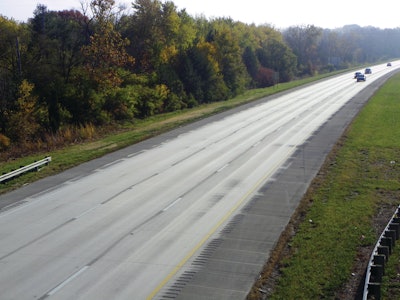
Interstate 270 is a beltway loop freeway in the Columbus, Ohio, metropolitan area, commonly referred to as “The Outerbelt.” It serves as the main route between Grove City, Interstates 71 and 670, and the Port Columbus International Airport. With an average daily traffic count of 76,123 vehicles, and 20 percent of the traffic comprised of trucks, a section of the concrete roadway in Grove City was experiencing above average noise levels caused by the transverse tined surface texture. The Ohio Department of Transportation (ODOT) had received noise complaints from local residents, prompting the department’s use of diamond grinding for noise reduction.
This project involved diamond grinding the existing concrete surface approximately 2 miles in both directions from mile markers 2.60 to 0.60 and the ramp sections of the State Route 62 exit. Originally the project called for 1/8-inch nominal grinding to remove the existing tining, but after realizing the additional benefits of diamond grinding, it was decided to remove up to an additional 1/4-inch to achieve improved ride quality. Further, the raised pavement markers, or centerline reflectors, were to be removed and replaced in their original locations during construction. There were two bridge sections on this project, where diamond grinding was performed on the deck surfaces as well. Working between the hours of 9 p.m. and 5 a.m., crews had to coordinate with an adjacent re-construction project to the west, posing traffic control and timing challenges.
Before and after On-Board Sound Intensity (OSBI) noise measurements were conducted, which showed that the newly ground surface resulted in a reduction of overall noise levels of 6 dBA in the east bound direction and 7 dBA west bound. The total project value was $455,344. The use of diamond grinding will likely eliminate the need for noise walls, which cost approximately $1 million per mile to construct. Local taxpayers will benefit from the diamond grinding for noise reduction, ride quality and cost savings. The rehabilitation was completed in September 2012.
According to Tom Makris, Construction Project Engineer at ODOT-District 6, they have received positive feedback from local residents. “One resident was quite impressed with the significant noise reduction once the profile grinding had been completed. Prior to this project, this resident stated that they could not sleep with their windows open due to the noise. Now, they can sleep with their windows wide open without any noise disruption from Interstate 270,” said Makris.
TEAM MEMBERS
- Ohio Department of Transportation (Owner)
- Safety Grooving & Grinding, LP (Prime contractor)
- Twin Rivers Construction (Deck sealing)
- A&A Safety (Painting)




















